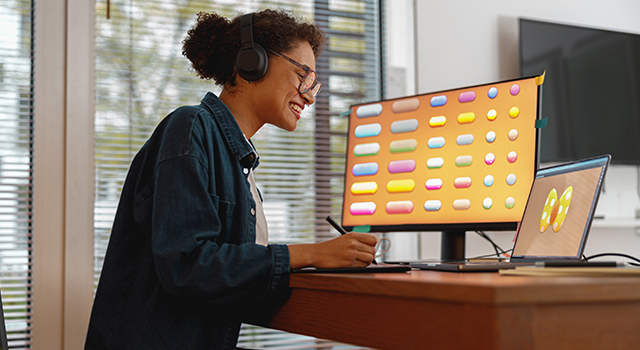As technology advances in virtual reality (VR), augmented reality (AR), and mixed reality (MR), the inevitable drive to enhance and beautify is an instinct human simply cannot avoid. We are at the forefront of this new technological movement as VR, AR, and MR pull us into an immersive and engaging reality like none we’ve seen before. However, once the base foundation is laid, we’ll always want to make adjustments to the way we imagine interact with the technology. When that happens, it will be the graphic designers who stream in, lending their experience and expertise to the VR developers as they seek to bring an even deeper experience than they thought possible.
Graphic Designers’ Essential Quality
Graphic designers will ultimately become the design architects of VR, AR, and MR as they progress past their infancy. That’s because graphic designers have one essential quality in their tool belt: creative ingenuity.
Once we go beyond the technical aspects of programming and developing for a virtual, augmented, or mixed reality – the need arises for those with a creative eye. Enter the graphic designer and artists. Just as websites started out simplistic and, in retrospect, fairly underwhelming in design, they’ve evolved into a creative medium all their own. We can thank graphic designers for that. So, too, will be the role of graphic designers in the realm of virtual reality as it continues to blossom.
Artwork Abode has been keeping an eye on the trends, and we can already see the following ways design has been and will continue to impact VR, AR, and MR:
- Gaming – One of the categories that are most ripe with creative design potential is the world of gaming. While VR developers structure the world, designers will be here to help dream up and create all the little nuances and aspects that make it truly breathtaking.
- Movies and Television – Graphic designers already help out with movie and television set design every day. This won’t be any different as we transition to a virtual environment. Set designers will still need those finishing touches only graphic designers can bring.
- Trailers – Movie and book trailers will evolve with the VR environment, which means a more immersive experience for everyone involved. But to engage and inspire the target audience, VR developers will want a graphic designer’s eye to polish the edges.
- Commercials – The ad industry already leans heavily on design, and this isn’t about to change. VR, AR, and MR give companies and industries a new platform to both create from and interact with their target audience. Graphic designers will be here to provide the designs, as well as offer creative suggestions not even in play yet.
- Books and magazines – VR impact far more than the typical moving mediums. AWA already sees the possibilities VR, AR, and MR bring to the book and magazine industry. As books and magazines become more interactive, designers will be here to provide their artistic flair—not only to the stories themselves but to the advertisements that may be a part of them.
- Education and Training – A less dramatic form of interactive medium, but still important none-the-less. Where PowerPoint designs currently reside, AWA imagines a world where VR, AR, and MR are the realm of education and training. Designers will provide the visual elements that seamlessly go with the material, but enhance it in a way to be more digestible to the student.
- More – We’re sure there are hundreds of additional ways graphic designers will impact this VR world that we haven’t even come up with. Time will tell as new trends develop and new needs arise.
This is, of course, in no way the entire list of ways design could and will impact the virtual reality market. These are, however, some of the most notable at this time. As we progress with the technology and the way we mesh the design world with the VR world, the sky is the limit for the outside-the-box ideas we’ll inevitably see.
How VR, AR, and MR Are Changing Graphic Design
Graphic designers aren’t only going to change the world of VR, AR, and MR. The opposite is also very true. Since its inception, virtual reality has been changing the way designers view their own world and the way they create. These include the following:
- Conceptual Product Design and Prototyping – Virtual reality is giving designers the platform to design conceptual products and prototyping in a way we only dreamed possible. As technology progresses and becomes more readily available, designers will be able to skip the cumbersome and often time-consuming prototyping process we currently use. This will, in turn, impact all of the following design areas:
- Cars
- Architecture
- Interior design
- New products
- 3D mockups – With AR, designers are able to go over all of their 3D designs and check over mockups. This includes designs of all kinds: brochures, folds, book covers, labels, billboards, etc.
- Immersive branding – Designers all around the world are already chomping at the bit to develop a more immersive branding experience. We’ll be able to engage audiences in the story behind a product or business in a more effective way.
- Creativity unlocked – In many ways VR, AR, and MR give graphic designers a godlike quality by providing us with endless possibilities for creation. Drawing with light, fire, or creating entirely new universes are literally at our fingertips.
Artwork Abode is excited for the future of design, as we mix our medium into the world of virtual, augmented, and mixed reality. We’re ready for a design future full of endless possibilities as we expand our reach for our clients. Whether you’re a client interested in VR and how it will impact your designs, or a VR developer looking to make more of an impact, contact us today to discuss your design needs.
– Artwork Abode



